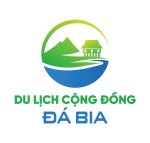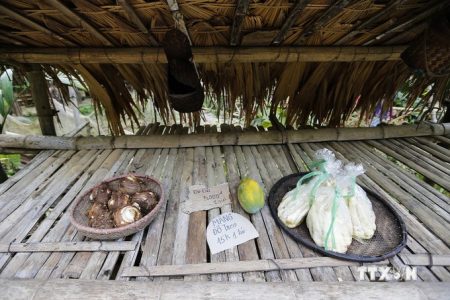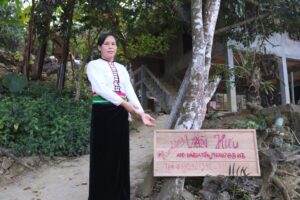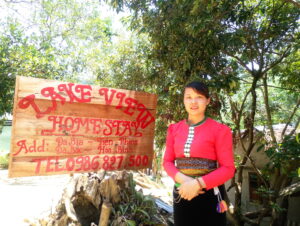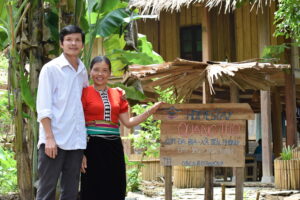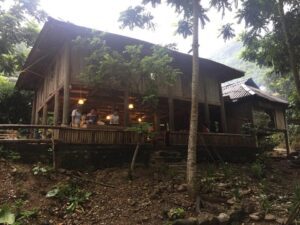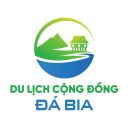TP – Called “self-service shops” because there are no sellers, customers who want to buy anything just need to put money in a lidless basket and carry the goods away, transactions are completely based on trust between the buyer and seller. This simple form of business is currently one of the reasons attracting many tourists to Da Bia village, Tien Phong commune, Da Bac, Hoa Binh.
THE FIRST SUPERMARKET OF THE AO TA MUONG PEOPLE
Lo Thi Trang, owner of the most famous Lake view homestay in Da Bia area, told us about the “self-service shops”: “The items in the shop all have clear prices and a bamboo basket is hung there to hold money. Without vendors, passersby gradually got used to buying and selling goods along the Da Bia hamlet.
My uncle once told me that there were people who drove regularly through this road, and that day they needed to buy something but didn’t have money with them. They wrote a note with an IOU, set a date to pay, wrote their name below, put it in the basket, took the goods away, and then came back to pay the next day.
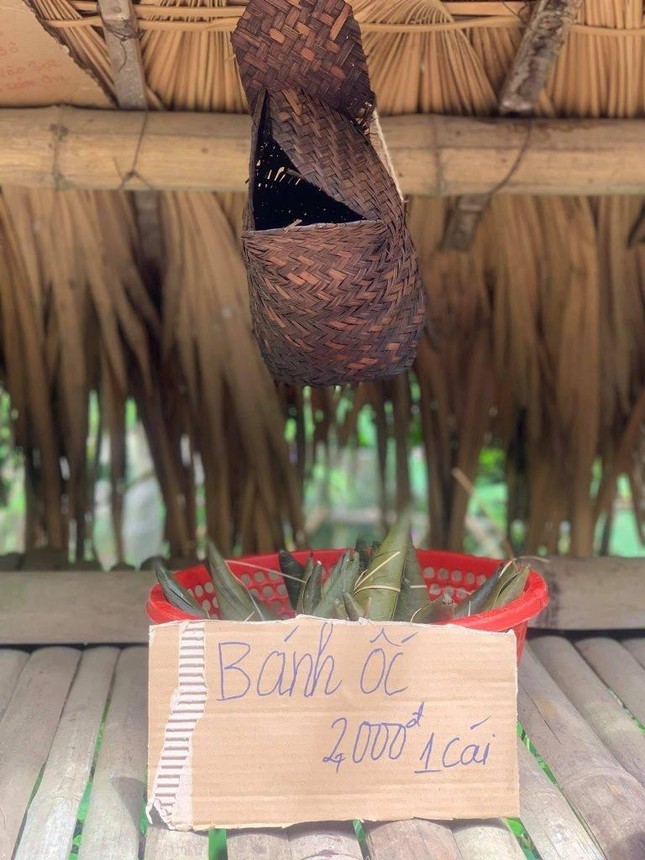
| Quan tu giac in Da Bia |
Mrs. Dinh Thi Yeu, Trang’s mother, added: “Quan tu giac” has been around for a long time, it is considered the first supermarket of the Muong Ao Ta people in Hoa Binh. Every day, goods are displayed for sale from early morning, before it is time to go to the fields, clear the goods, and check the goods when it is dark.
With the characteristic of self-sufficiency, every Muong family can live well without depending on the market or supermarket… Vegetables, rice grown, chickens, and ducks raised are mainly for home use, and only a little surplus is sold. Previously, “self-conscious shops” were scattered throughout the village.
At that time, there was a rumor that the goods at the “self-conscious shops” were all cursed, if anyone bought goods without putting money in the basket, they would not know the way out of the shop, or if they took the goods, they would encounter some trouble later. Gradually the shop existed without any theft or default.

Chi Lo Thi Trang
In Da Bia, there are currently three “Tu Giac Quan”. The so-called “quan” is actually just a bamboo stall with a roof, on which are displayed seasonal agricultural products of the Muong people such as: taro, vegetables, tubers, fruits, snail cakes, pickled bamboo shoots, sugar cane, etc. If the shop was originally established with the purpose of selling goods, it has now become a “tourist specialty” that attracts the attention of many tourists.
Mrs. Yeu said that the “Tu Giac Quan” is not owned by any particular household but is a shared “store”. Any household that has something to sell can bring it to the stall to “consign”. Bargaining and bargaining of course do not exist here. The profit of the restaurant is not much, but people still like to maintain it as a way to promote the beauty of the Muong people to visitors and tourists.
Another interesting thing is that during the COVID-19 outbreak, the “Tu Giac Quan” has fully utilized its function by maintaining the circulation of goods while minimizing contact, avoiding the spread of the disease.
Ms. Nguyen Thi Thuy An, a tourist from Ho Chi Minh City, shared: “We came here because we were curious about the “Tu Giac Quan”. But once we got there, we wanted to come back because the food here is delicious, the scenery is beautiful, and the air is fresh. The story of the Muong people living in the mountains is also very interesting.”
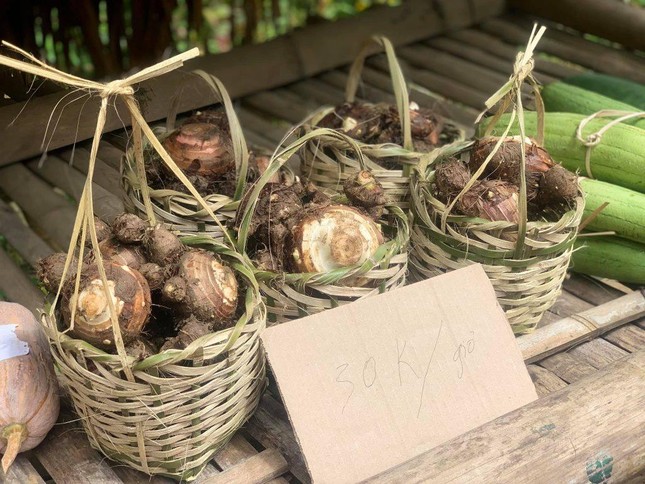
Goods at “Quan Tu Giac”
After hearing the real and fictional stories about the Muong Ao Ta people, Mr. Tuan Anh (Hanoi) concluded: “I have been to many places and have seen people exploiting indigenous folk culture in tourism very popularly. For example, when I went to Truong Gia Gioi, China, I heard stories about the art of blocking the dead, which was very impressive, although nowadays no one uses this method to “lead” the dead back to their hometowns anymore.
“Quan Tu Giac” is an interesting tourist attraction in Hoa Binh that no other place in Vietnam has. I think if we continue to exploit indigenous culture in this way, we will create more unique tourism products that attract visitors.”
“WHO EXPECTED THAT WATERING VEGETABLES IS SO LIKED BY PEOPLE”
Taking her children to Da Bac to experience mountain life, Ms. Huynh Thu Yen (Hanoi) said: “The children like the most the act of watering vegetables. At the homestay, there is a small vegetable garden, and every afternoon the owner brings a bucket out to water the plants. When my children discovered that the vegetable watering tool here looks exactly like a water gun, they all competed to do it. The people of the past really always had surprising innovations.”
Mrs. Luong, a resident of Da Bia village, exclaimed: “Who would have thought that watering vegetables would make people like it? Before, when some Westerners came to live there, they always argued with me about the job. Muong people have been using this watering method since ancient times. In the past, there was no misting irrigation system like today, so the elders came up with the idea of manually making rain with bamboo tubes.
The men in the house just need to go to the forest to find old bamboo tubes (both durable and light), then add a simple piston, and then it becomes a giant cylinder, dip the cylinder in water, suck it up, then point it to the desired place to water, press the piston and it’s done. The watering range can be as far as 3-4 meters. “For those with small gardens, they only need to stand in one place to water the whole garden.”
The Da Bia area is located next to the Da River, where people mainly live on farming, aquaculture and fishing. Realizing that the rich natural resources and indigenous culture of this place are suitable for community tourism, in 2014, the organization Action on Poverty (AOP) in Vietnam chose this place to develop the “Community Tourism” project.
Unlike many other tourist destinations, to get to Da Bia hamlet, instead of going by car or motorbike, the easiest way is to go by waterway on Hoa Binh Lake. The journey from Thung Nai port to Da Bia hamlet takes about an hour, passing through beautiful landscapes that are considered as “Ha Long Bay on the mountain” of Vietnam.
The Muong Ao Ta people, because they have been trained in tourism, can more or less communicate simply in English with foreign guests. They also often add small initiatives that surprise visitors. For example, right in her homestay, Ms. Trang has a place to watch the lake decorated with recycled flower vases and attracts female guests with a sign: “Sit still, love will come”! According to my observation, most guests at the homestay will not be able to stop themselves from taking photos right next to this funny slogan.
Among the stories in Da Bia, there are also riddles that attract visitors. For example, Mrs. Yeu asked us whether the Muong people make stairs in even or odd numbers. Some said even, some said odd, and we argued for nearly an hour. Finally, she said odd. Because according to the Muong people’s concept, odd numbers symbolize fertility and luck, so the stairs must have an odd number. In addition, the Muong people assume that odd numbers represent positivity and even numbers represent negativity, so they especially avoid making stairs with even numbers and are only allowed to make stairs with even numbers when building tombs for the dead.
Naturally, we remembered the story of the odd-numbered stairs without having to make any effort.
BRINGING ANCIENT DISHES TO THE DINING TABLE
According to the summary of those working in tourism in Da Bia, the two dishes most requested by guests are very elaborate ancient dishes.
The first dish is called canh dua or canh can nghien – a dish Muong Ao Ta’s food is made from the main ingredient of the nựa tree. This is a species of araceae, growing wild in the forest, usually from May to July, so visitors who want to eat canh da must come to Da Bia in the summer. The tree, after being carefully selected and processed (because if not processed carefully, the dish will be itchy), will produce a bowl of green soup, with a slight sour taste of me, combined with the richness of the local pork, a taste experience that makes people want to try it again.
Lo Thi Trang said that her canh da dish was once praised by musician Nguyen Cuong, and foreign tourists have also repeatedly given this rustic dish a thumbs up.
Another culinary specialty that must be tried when coming to Da Bia is the dish of stewed fish. If you want to enjoy this elaborate dish, you must definitely order in advance because the steamed fish dish must be cooked for 5-7 hours to meet the requirements. The steamed fish dish is processed similarly to steamed fish in the lowlands. The fish steamer is called “cai ot” by the Muong people, and has a similar shape to a sticky rice steamer. After being pre-processed, the fish is marinated with spices such as salt, pepper, ginger, lemongrass, chili, and doi seeds for about 30 minutes to absorb, then mixed with lots of bamboo shoots, wrapped in banana leaves and placed on the steamer, steamed for 5-7 hours.
A delicious and satisfactory steamed fish dish must be cooked until it is soft and not mushy. Both fish and bamboo shoots are mixed with fragrant spices, soft and sweet, you can chew the bones.
Source: tamviet.tienphong.vn
